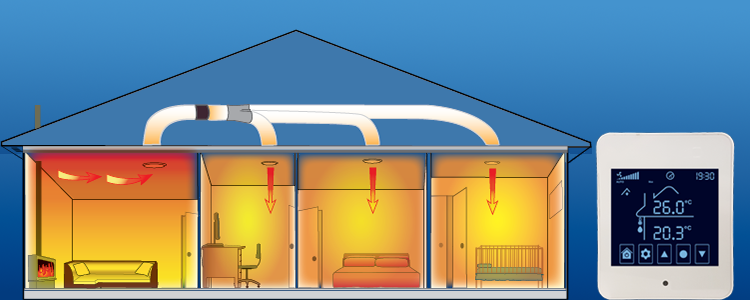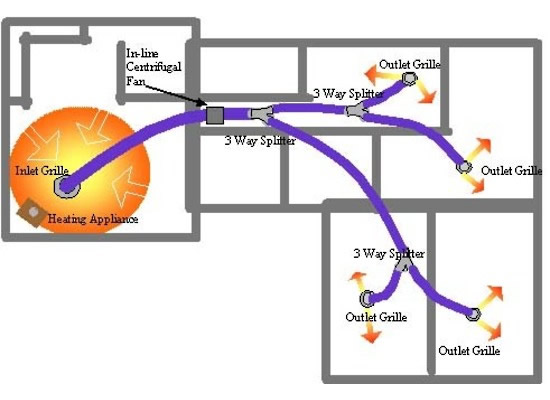DVS Heat Transfer Systems: The Future of Energy-Efficient Industrial Heating Solutions
Wiki Article
A Comprehensive Guide to Picking the Right Heat Transfer Solutions for Your Demands
Choosing the ideal Heat transfer system is important for functional effectiveness. Different systems deal with different requirements, affected by variables such as temperature range and fluid type. Understanding the concepts behind Heat transfer, such as convection, conduction, and radiation, is crucial. In addition, reviewing energy sources and upkeep practices can impact long-term performance. A closer examination of these considerations exposes exactly how to customize a system to specific needs. What should one prioritize in this complicated decision-making process?Recognizing Heat Transfer: Key Ideas and Principles
Heat transfer might appear like a straightforward principle, it incorporates an array of principles that are basic for efficient system design - DVS Heat Transfer Systems. Comprehending these concepts is important for engineers and designers that aim to optimize thermal performance in numerous applications. Transmission, for instance, entails the transfer of Heat with solid materials, while convection refers to the activity of Heat within liquids. Radiation, another crucial principle, explains how Heat can be moved with electro-magnetic waves. Each of these devices plays an important duty in figuring out exactly how energy moves within a system. By thoroughly understanding these principles, experts can make enlightened choices, ensuring that Heat transfer systems operate effectively and meet the certain demands of their applications
Sorts Of Heat Transfer Equipments: An Overview
Understanding the concepts of Heat transfer prepares for discovering the numerous kinds of Heat transfer systems offered. Heat transfer systems can be categorized largely into three types: transmission, radiation, and convection. Conduction entails Heat transfer through solid materials, counting on straight call in between bits. Convection, on the various other hand, happens in fluids (gases and liquids) where the activity of the liquid itself promotes Heat transfer. Radiation entails the transfer of Heat through electro-magnetic waves and does not require a tool, enabling it to take place in a vacuum cleaner. Each kind of system has unique attributes and applications, making it essential for people and organizations to very carefully analyze their specific demands when choosing one of the most suitable Heat transfer solution.Applications of Heat Transfer Solutions in Different Industries
Heat transfer systems play an essential role across numerous markets, affecting effectiveness and item top quality. In commercial manufacturing procedures, they assist in accurate temperature control, while in food and beverage processing, they ensure safety and security and preservation. In addition, heating and cooling and climate control systems rely greatly on reliable Heat transfer to maintain comfy atmospheres.Industrial Production Processes

Many industrial manufacturing procedures rely heavily on effective Heat transfer systems to take full advantage of efficiency and improve product high quality. In markets such as metalworking, Heat exchangers play a vital duty in keeping perfect temperature levels throughout welding, casting, and creating. These systems ensure uniform Heat distribution, which is vital for achieving desired material buildings. In the chemical production sector, Heat transfer systems assist in precise temperature control during reactions, affecting return and security. Moreover, in textile manufacturing, efficient Heat management is very important for coloring and ending up processes, affecting shade consistency and material high quality. By picking appropriate Heat transfer innovations, makers can improve power efficiency and reduce functional costs, inevitably bring about a much more lasting and affordable manufacturing atmosphere.
Food and Beverage Handling
Reliable Heat transfer systems are equally crucial in the food and beverage processing sector, where maintaining optimal temperatures is crucial for food safety and security and high quality. These systems play a necessary duty in procedures such as cooking, pasteurization, and sanitation, making sure that products are safe for usage and preserve their dietary worth. Heat exchangers, for circumstances, successfully transfer Heat in between liquids, optimizing energy use while decreasing temperature level changes. Furthermore, refrigeration systems are fundamental for expanding and protecting perishable products service life. The choice of Heat transfer modern technology straight impacts functional efficiency and item honesty, making it vital for food and beverage suppliers to select the appropriate systems customized to their details handling demands. This cautious option eventually contributes to consumer satisfaction and food safety.
A/c and Climate Control
While lots of sectors count on Heat transfer systems for effectiveness, A/C (Heating, Air Flow, and Air Conditioning) plays an important duty in preserving interior environment control throughout different setups. These systems utilize Heat transfer concepts to control moisture, temperature level, and air quality, guaranteeing convenience and safety and security in domestic, commercial, and commercial settings. Appropriately designed a/c systems boost power efficiency, lower operational costs, and reduce ecological influence. In business structures, as an example, effective environment control adds to worker efficiency and client contentment. In industrial applications, heating and cooling systems help keep ideal conditions for devices procedure and product preservation. Choosing the appropriate Heat transfer system is essential for meeting details environment control requirements and attaining overall system efficiency.Evaluating Power Sources for Heat Transfer Equipments
In assessing power sources for Heat transfer systems, a contrast of sustainable power choices and fossil fuel considerations is important. Sustainable sources, such as solar and wind, offer lasting options that can minimize ecological effect. On the other hand, fossil gas stay common due to their established facilities and energy density, triggering a careful assessment of both options.Renewable Power Options

Nonrenewable Fuel Source Factors To Consider
Examining fossil fuel factors to consider is crucial for the performance and sustainability of Heat transfer systems. Nonrenewable fuel sources, such as all-natural gas, oil, and coal, are traditional energy sources that give substantial Heat output, making them preferred choices for commercial and domestic applications. However, their ecological influence, including greenhouse gas exhausts and source DVS Heat Transfer Systems deficiency, increases concerns. When choosing a heat transfer system, it is important to examine the availability, expense, and governing elements related to these gas. Furthermore, the performance of nonrenewable fuel source systems need to be considered, as greater efficiency can minimize some ecological disadvantages. Inevitably, a well balanced method evaluating performance and sustainability can direct decision-makers towards one of the most appropriate Heat transfer solution for their certain demands.Aspects to Consider When Choosing a Heat Transfer System
Picking a suitable Heat transfer system needs mindful consideration of numerous variables that can significantly impact performance and performance. One important factor is the operating temperature range, which determines the products and design suitable for the application. In addition, the sort of fluid used in the system-- whether gas or liquid-- affects Heat transfer performance and compatibility. The system's dimension and capability should line up with the details demands of the procedure to prevent inefficiencies. Energy resource schedule is likewise crucial, influencing operating expense and sustainability. Moreover, the installment environment, consisting of room constraints and availability for maintenance, plays a significant function in system option. Finally, governing compliance and safety and security standards must be thought about to assure the system meets all legal demands.Maintenance and Performance Optimization for Heat Transfer Systems
Maintaining Heat transfer systems is vital for guaranteeing optimal effectiveness and longevity. Routine upkeep tasks, such as cleaning Heat exchangers and evaluating insulation, assistance protect against effectiveness losses because of fouling and thermal bridging. Furthermore, checking system parameters, including pressure and temperature level, enables for early detection of anomalies, decreasing downtime and pricey fixings. Implementing a precautionary maintenance timetable can enhance efficiency and extend the life-span of parts. Updating to advanced control systems can enhance functional effectiveness by adjusting to varying conditions and lots. By prioritizing maintenance and efficiency optimization, drivers can attain reduced energy intake, reduced operational prices, and boosted total system dependability, ultimately causing better resource application and an extra lasting procedure.Future Patterns in Heat Transfer Technologies
As industries increasingly prioritize sustainability and power efficiency, future fads in Heat transfer technologies are readied to go through considerable makeovers. Technologies such as innovative products, consisting of carbon nanotubes and nanofluids, promise boosted thermal conductivity and performance. Additionally, the combination of sustainable energy resources right into Heat transfer systems is gaining momentum, advertising environmentally friendly remedies. Smart technologies, consisting of IoT sensors, are expected to reinvent monitoring and control, allowing real-time information evaluation for optimized performance. Additionally, the development of portable and modular systems will certainly promote simpler installation and upkeep, catering to diverse applications. These improvements show a change towards even more sustainable, effective, and adaptable Heat transfer remedies, straightening with global energy objectives and ecological criteria.
Often Asked Concerns
What Are the Ecological Effects of Heat Transfer Systems?
The ecological impacts of Heat transfer systems can consist of greenhouse gas emissions, energy usage, and potential thermal contamination. Furthermore, improper disposal of products and ineffectiveness can add to resource exhaustion and ecosystem disruption.Just how Do I Determine the Cost-Effectiveness of a Warm Transfer System?
To determine the cost-effectiveness of a warm transfer system, one have to assess preliminary prices, operational expenditures, maintenance requirements, and power efficiency, contrasting these variables against the anticipated lifespan and performance of the system.Can Heat Transfer Systems Be Made Use Of in Residential Setups?
Heat transfer systems can certainly be utilized in domestic settings. They give reliable heating and cooling down remedies, making homes much more comfortable while possibly decreasing power prices. Their versatility permits for numerous applications in domestic environments.What Safety Rules Relate To Heat Transfer Solutions?
Safety laws for Heat transfer systems commonly consist of standards on procedure, setup, and upkeep. Compliance with local structure codes, maker specifications, and market standards is important to assure effective and safe system efficiency in numerous applications.Exactly How Do Different Materials Affect Heat Transfer Performance?

Conduction, for circumstances, includes the transfer of Heat with solid materials, while convection refers to the movement of Heat within fluids. Comprehending the principles of Heat transfer lays the foundation for exploring the numerous kinds of Heat transfer systems offered. Heat exchangers, for circumstances, efficiently move Heat in between fluids, enhancing power usage while reducing temperature variations. In reviewing power sources for Heat transfer systems, a comparison of sustainable power options and fossil fuel considerations is crucial. Steels, such as copper and aluminum, conduct Heat properly, whereas insulators like rubber and glass slow down Heat flow.
Report this wiki page